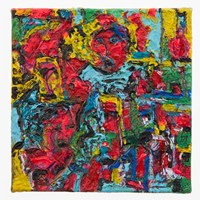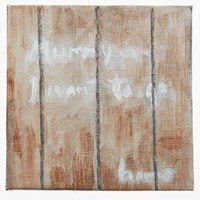Attache Case: creating a collective artwork
I see that art has played a vital and important role in my life, not just my life but in other lives as well. I see myself as a voice, not just for my experience. It has not been my experience only, it’s been the experience that I have shared with many others.
Azizeh Astaneh, Attache Case artist, 2021
In 2015, curator, writer and artist Peter Burke invited current and former asylum seekers and refugees in Narrm/Birrarangga (Melbourne) to create artworks for an international touring installation that addressed their experiences. The artists, some of whom were living in detention centres at the time, came from countries including Afghanistan, Columbia, Egypt, Iran, Iraq, Poland, Hungary, Sri Lanka and Vietnam.
Some artists were contacted through Melbourne Artists for Asylum Seekers with the assistance of Azizeh Astaneh (who also contributed artworks), and Margaret Mayhew who ran art workshops at the Melbourne Immigration Transit Accommodation Centre in Broadmeadows.
Attache Case now consists of 41 miniature artworks by 21 artists, contained in a re-purposed doctor’s medical case once used by Peter’s uncle to make house calls. Sixteen of the artists also provided photographic portraits of themselves. The works explore diverse issues about detention, Australian immigration and refugee policies, political injustices, lives in limbo and resettlement. The project poignantly captures the personal experiences of people who have sought refuge in Australia and gives voice to those who are seldom heard or seen.
Peter reflects:
For this project, I invited asylum seekers and refugees in Melbourne to address their refugee experience through art. Each artist was provided with a blank canvas and they responded in their own, individual way.
Many artists wrote titles, explanations and messages on the reverse of their artworks which range from hope to anger to despair. Tadros Hanna asks the viewer: ‘Our journey starts inside our heart. My journey is a journey from pain to hope. What about yours?' While Duane (Noony) Falconer writes: ‘When one accepts death. Only then they will hear the Song of Silence.’
This collective piece has been created by artists united by their own personal search for safety, freedom and a home – and the courage to share their frustrations, hopes and fears. They invite us to question our assumptions, speak out against injustice and embrace diversity in all its forms.
Art: outlet for trauma and tool for protest
When a soul has departed
Your door is injured and you
Gaze at life through misery in
The hope for somebody to
Look back and acknowledge my existence.
Alyana Eau, 2015
Alyana Eau fled her home in Iraq in 1998, and her words express the grief of loss and the horror of invisibility experienced by asylum seekers and refugees buried in the detention and immigration system.
Many of the Attache Case artworks and accompanying messages are both provocative demands to be seen and heard, and calls to action. Art is the medium through which artists can express their complex thoughts and feelings through a universal visual language beyond words and borders. As Alyana, who contributed Waiting 1991 Gulf War - Zakho, Iraq reflected in 2021:
Through art, I can convey what words cannot portray and I express myself without boundaries or limitations. Art to me is more influential and powerful than any language, it is freedom of thought, and it is what my emotions speak.
For Mehdi Jaghuri, a Hazara from Afghanistan who arrived in 2005, art provides a way to convey the injustices of what he left behind (Children at Work). Rayka Kouchaksaraei, an asylum seeker from Iran, requires the viewer to see and remember Reza Barati who was murdered by guards and other contractors during the violent riot on Manus Island in 2014 (Life and nothing more [2]).
Azizeh Astaneh (Iran) uses fire as her provocative symbol stating ‘Policies burn lives’ (Sisters). Recurring images of solitary figures in endless limbo, silenced and unheard are conveyed by a number of artists including Gyorgyi Marek (Hungary) in No eye, no mouth, no will. Sriharan Ganeshan (Sri Lanka) paints a a security guard kicking a milk bottle, a symbol of the trauma inflicted on children in detention (Child in Camp).
The constant tension between hope and despair is symbolised in Mitra Ashanti’s (Iran) painting Expectation and she reflects:
That painting showing how was hard life when you waiting for hope and then because they did not care about me and people like me and all of my dream that I had in my brain gone like a birds flying and escaping from the cage.
Yet art is also a conscious act of defiance. Saki Eghbal (Iran) takes the opportunity in Attache Case to symbolically break from a chain in her work No stating: ‘I will say NO to injustice - NO to Disappointment - NO to Despair.’ Perhaps Saki is also urging us to do the same
Life in limbo
I want to study, that’s all I want. It’s about 6 years I’m waiting the time…I said that many times but no one heard me. So I decided to draw my feeling…to let them see how I feel.
Saki Eghbal, 2014 (no portrait available)
Life for people seeking asylum is a state of endless uncertainty. These experiences are conveyed by many Attache Case artists who have endured the protracted waiting for many years to be assessed, processed, and, if fortunate, finally gain permanent residency in Australia. A life in limbo is one of stress, insecurity, and even despair.
Activism through art
In detention…they want to crack you in some way. In my…artworks I tried to say don’t forget these two and many others who were killed by neglect and horrific acts in detention.
Rayka Kouchaksaraei, 2021
Art provides a powerful way to express thoughts, feelings and actions when people feel their voices have been silenced. Some Attache Case artists use their work to take a stand against injustices in their countries of origin, and the inhumanity of treatment of many asylum seekers in detention.
Voice to trauma
I represented a characterless, foggy portrait of a refugee. In a refugee camp you become a number, and no one sees your face.
Gyorgyi Marek, 2021
People seeking refuge from violence and persecution are already carrying the burden of trauma – loss of homeland, loved ones and basic human rights. This trauma, expressed by Attache Case artists, can be compounded by experiences of powerlessness, loneliness and dehumanisation while in detention – and by endless waiting for a secure future.
Finding a home
Everyone is looking for their home, where they can feel accepted, understood, comfortable, and appreciated. Home is inside our hearts not outside. Art is my home.
Tadros Hanna, 2018
Home represents safety, security and family. It is more than four walls and a roof – but a community, a place to belong, to express culture, language, self. These Attache Case artists reflect on different notions of home, the search for identity, connection and acceptance.
Acknowledgements
All artworks and images are part of Museums Victoria’s collection and have been reproduced with permission of the artists and photographers.
Immigration Museum wishes to acknowledge the curatorial assistance of Peter Burke and Dr Anh Nguyen in the development of this collection and display.












































